|

GW Sets Leadership Course for the Future | University Strategic Plan Takes Shape | Washington Breeze | Graduate Student Discovers New Type of Star | Monroe Breaks Scoring Record | Hall of Fame Athletes | A-10 Title | Faculty Focus: Dancing With Science | At a Glance | Birthday Party | GW in History

|
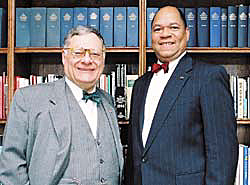
President Trachtenberg re-ups to lead GW through 2007. John F. Williams assumes the role of provost.
Claire Duggan
|
GW Sets Leadership Course for the Future
Trachtenberg Signs New Five-Year Contract; Provost Appointed
Through a series of major management decisions solidified this academic year, GW has planned the future of its leadership for much of the rest of this decade.
The University’s Board of Trustees announced that GW President Stephen Joel Trachtenberg has signed a new five-year contract and will lead the University through 2007. Trachtenberg has served as president of GW since 1988 and has guided the University’s emergence as a major national research institution.
During the Trachtenberg administration, GW has steadily risen among the nation’s four-year institutions of higher education.
As a result of Trachtenberg’s travels on behalf of GW and his growing involvement in the community, including his new role as chair-elect of the District of Columbia Chamber of Commerce, he has reinstated the position of University provost. The provost is the person who represents the University and handles day-to-day administrative duties whenever the president is away. GW last had a provost in 1989. Trachtenberg had eliminated the position early in his tenure to streamline the administration.
“When I first came to GW in 1988, I was keen to get to know as much about the University as I could,” he says. “Now after 15 years here, I feel comfortable that when I’m not on campus, there is someone who can be a spokesman for the University.”
In January, Trachtenberg appointed John F. Williams, MD ’79, EdD ’96, GW’s new provost. As provost, Williams retains his titles as vice president for health affairs and dean of the School of Medicine and Health Sciences.
Williams will serve a three-year term as provost. He has been vice president for health affairs since 1997, and became dean of the School of Medicine and Health Sciences in 1999 after serving as executive dean. Over the years, Williams has overseen the construction of the new hospital and has been a key leader in emergency preparedness planning efforts for the District of Columbia.
Recently, Homeland Security Secretary Tom Ridge appointed Williams as a special adviser on medical-related homeland security issues. During his tenure, Williams also has spearheaded GW’s efforts to integrate “best practices” into local, regional, and national preparedness efforts. Partly as a result of Williams’ leadership, GW recently received $5 million in the FY ’03 federal budget to establish a first responder training center on its Virginia Campus in Loudoun County.
Along with the appointment of Williams as provost, Trachtenberg announced the promotion of three other top administrators—Louis H. Katz, Donald R. Lehman, PhD '70, and Robert A. Chernak, Ed D '97—to reflect their accomplishments over the years and growing challenges to their management portfolios.
Katz is now executive vice president and treasurer; Lehman is executive vice president for academic affairs and the George Gamow Professor of Theoretical Physics; and Chernak is senior vice president for student and academic support services. All three will play key roles in an overall strategic plan the University is implementing to achieve a higher level of academic excellence and of the services provided by the University (see related story).

University Strategic Plan Takes Shape
After experiencing more than a decade of steady climb through the ranks of top-tier institutions, University leadership is plotting an aggressive new course to elevate the school’s educational and national recognition even further.
Known on campus as the “strategic plan,” its largest component is the bolstering of the undergraduate programs. The University’s graduate and doctoral programs, many of which already enjoy a national reputation, also will receive attention, as will business aspects of GW’s operations.
A key element of the plan is a re-emphasis on writing at the undergraduate level. Current plans call for the implementation of an intensive freshman writing course and discipline-specific writing intensive courses to be taken by sophomores and juniors. Some freshmen will begin taking the new writing course this fall.
In addition, committees in charge of directing the strategic plan have pinpointed seven “areas of excellence” on which the University should concentrate additional resources to create an/or continue programs of national prominence. Proposals were submitted by faculty members and evaluated based on their current University assets, use of Washington-area resources, and relation to undergraduate education. The following areas were selected for additional investment:
- Transportation, Safety, and Security
- Public Policy and Public Administration
- The Sigur Center for Asian Studies
- Biomedical Engineering
- Political Science
- History
- Human Evolution
Combined, these seven areas have received an additional $482,500 this fiscal year, with more support planned for the future. The University expects the fruits of this effort to be evident within three or four years.
In addition, by the end of 2004, GW will have invested $1.5 million in more graduate student support, raising minimum stipends (independent of tuition) to at least $15,000 an academic year for a majority of graduate assistants and targeting additional funding for graduate assistants in specific programs. GW also has doubled its contribution for graduate assistants who enroll in the University’s student health plan from $500 a year to $1,000.
A doctoral programs review committee, appointed this past fall, also is assessing the status of each of GW’s 48 doctoral programs.
The University will be monitoring the progress of these combined efforts in the next few years. More on the strategic plan will be covered in future issues of GW Magazine.

Washington Breeze
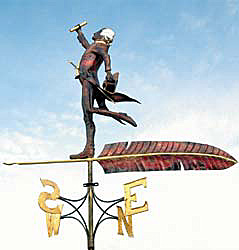 GW’s newest artwork—a weathervane in the likeness of George Washington—is whipping in the wind atop the Women’s Studies building at the corner of 22nd and Eye Streets. It was designed by the late Travis Tuck and donated to the University by Trustee Luther Brady. GW’s newest artwork—a weathervane in the likeness of George Washington—is whipping in the wind atop the Women’s Studies building at the corner of 22nd and Eye Streets. It was designed by the late Travis Tuck and donated to the University by Trustee Luther Brady.
Tuck is a celebrated artisan of the Martha’s Vineyard area in Massachusetts. His weathervanes of copper and bronze were highly sought after by collectors. He produced weathervanes that are now located in 43 states and 11 countries.
Tuck’s break as an artist came when the movie Jaws was being filmed in 1974. He was commissioned to make a weathervane for Quint’s shark house in Menemsha, Mass. Although the object never appeared in the movie, the shark design was replicated. He went on to garner the business of several famous clients, including Bill and Hillary Clinton, Steven Spielberg, James Taylor, Beverly Sills, and Bloomingdale’s, New York.
The George Washington weathervane was perhaps Tuck’s final commission, or among his very last. It is unique in its figurative elements, including the gold quill, the scroll, hat, sword, and silvery hair. The golden details and sprightly step make it an important sculptural icon for GW’s legacy.
Photo by Claire Duggan
|

Graduate Student Discovers New Type of Star
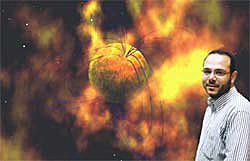
A NASA rendering of a magnetar. (Right) Alaa Ibrahim, a physics graduate student, confirmed the existence of magnetars.
NASA
|
As a boy in Egypt, Alaa Ibrahim would conduct scientific experiments to produce hydrogen to fuel his model space shuttle. As a physics doctoral candidate at GW, he ended up studying stars instead of traveling to them.
Under the tutelage of Jean Swank from NASA’s Goddard Space Flight Center in Maryland and GW Professor of Physics William Parke, Ibrahim recently approved the existence of a new type of star, called a magnetar, which is more powerful than any kind of star previously known to exist.
About a decade ago, scientists theorized that the universe contained magnetars, but they had never been able to find direct evidence of their existence—that is, until Ibrahim poured through large amounts of data on energy being emitted from a star named SGR 1806-20, which was believed to be a magnetar. Ibrahim discovered that SGR 1806-20 has the most powerful large-scale magnetic field detected in the universe.
“If this magnetar took the place of our moon, its magnetic field would strip the Earth of every piece of metal and rearrange the molecules in our bodies,” Ibrahim muses. “Luckily, it is 40,000 to 50,000 light years away from Earth.”
A one-second burst of energy from a magnetar is roughly equivalent to the amount of energy radiated by our sun in one year. Ibrahim, who has taught introductory courses in astronomy and physics at GW since 1998, realizes the implications of his discovery but is not weighed down by its enormity.
“This discovery is just one step in a long journey toward learning more about our universe and magnetars in particular,” he says. Researchers’ interest in this type of star began March 5, 1979, when an immense burst of gamma rays hit space probes and then the Earth. The burst disrupted radios momentarily and sent gamma ray detectors off the charts. It was not until 1992 that scientists put forth a theory that magnetars existed and that their incredibly strong magnetic fields cause the stars’ solid crusts to crack and shoot out powerful bursts of gamma rays.
In 1998, Ibrahim began conducting research on magnetars at Goddard, along with teaching at GW. In combing through data available from NASA’s Rossi X-ray Explorer satellite, Ibrahim identified information that pointed toward a proton moving in an immense magnetic field near SGR 1806-20. He realized that this finding would allow for direct measurement of the star’s magnetic field, confirming the amazing strength of that magnetic field and the existence of magnetars.
Ibrahim sought the advice of astrophysics experts to help him with the research and publication of his discovery. The international collaboration included Parke; Swank; Samar Safi-Harb of the University of Manitoba, Canada; Robert Turolla of the University of Podova, Italy; and Silvia Zane of the Mullard Space Science Laboratory in the United Kingdom.
The initial results of the team’s discovery were published in a June 26 article in the Astrophysical Journal Letters, and a more comprehensive report appeared in the same journal Dec. 10. Ibrahim speaks about the hard work he and his co-authors put into this research but nonchalantly admits, “The data I analyzed [from SGR 1806-20] for my thesis was public for years and nobody looked at it.”
Ibrahim will continue to study SGR 1806-20 and be at the forefront of research on magnetars. He hopes to earn his doctorate this year, and, he sees research and teaching in his future.
—Matthew Lindsay

Monroe Breaks Scoring Record
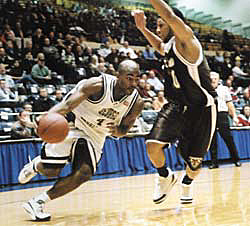
Thom Kohout
|
With a pair of free throws with 37.8 seconds left in the GW-Massachusetts game March 10, Chris Monroe broke a 44-year-old record when he tied and then broke the record held by Joe Holup, BBA ’56, for most career points in GW men’s basketball history.
Monroe finished out the season in the Colonials A-10 tournament quarter final loss against Xavier March 13. The added 22 points put Monroe’s GW career points total at 2,249.
A senior from nearby Hyattsville, Md. (Good Counsel High School), Monroe is in great hoop company, as his career scoring record groups him with other past local stars, including Juan Dixon of Maryland (2,269), Patrick Ewing of Georgetown (2,184), Len Bias of Maryland (2,149), and Alonzo Mourning of Georgetown (2,001).
Throughout his four years at GW, coaches and teammates praised Monroe’s work ethic, both on and off the court.

|
Hall of Fame Athletes
Six former GW athletes and one former coach were inducted into the GW Athletic Hall of Fame Feb. 14. The honorees were (from left): Jim Goss, ’79, baseball; Shannon Higgins-Cirovski, coach, women’s soccer ’91–’97; Wade Hughes, ’85, wrestling; Karin Vadelund, ’90, women’s basketball; Sonni Holland, ’93, men’s basketball; Svetlana Vtyurina, ’96, volleyball; and Lisa Shafran, ’95, women’s tennis.

Claire Duggan
|
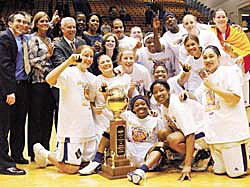
A-10 Title
The Colonial Women, with coach Joe McKeown, beat Rhode Island 56-49 March 10 at GW’s Smith Center to take the Atlantic 10 Conference Title. Their trip to the NCAA tournament this year is the 10th in 13 years, but this year marks their first A-10 championship since 1996.
Claire Duggan
|

Faculty Focus: Dancing With Science
A Series of Personal Glimpses of GW Faculty Members
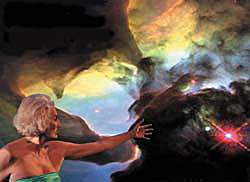 Maida Withers, professor of choreography and dance, takes the art of dance to a scientific level. Through her work, Withers often makes connections between nature and man, art and science. Combining video, and light, and sound with the human movement of dance, Withers and her Dance Construction Company capture the attention of the audience while encouraging a unique perspective on diverse aspects of our universe. Maida Withers, professor of choreography and dance, takes the art of dance to a scientific level. Through her work, Withers often makes connections between nature and man, art and science. Combining video, and light, and sound with the human movement of dance, Withers and her Dance Construction Company capture the attention of the audience while encouraging a unique perspective on diverse aspects of our universe.
In “Dance of the Auroras—Fire In The Sky,” Withers and her dancers interact in real time with a magnificent multimedia installation, bringing to life the natural phenomenon of illumination of the sky known as the Aurora Borealis. The performance features cyberworld images of the sun from NASA, and photographic and video images of the auroras projected on stage. Dancers alter and manipulate the images with a wireless mouse, creating an interactive dimension during the performance.
As part of her exhaustive research for the Aurora project, Withers traveled to distant arctic regions in search of the aurora and worked closely with national and international scientists in an effort to comprehend the brilliant natural phenomenon.
So it is with no surprise that Withers has selected another scientific backdrop for her latest performance, a culmination of her life’s work. On Feb. 14 and 15, Withers presented her one-woman show, “Maida on Maida in the Universe.” In it, a multimedia installation revealed Withers’ immense body of work, projecting images from past performances while she performed on stage and reflected on her life’s work through personal monologue and dialogue with the audience.
Withers began dancing as a child in a small town in Utah. She was choreographing with her teacher by age 11 and has been consumed by choreography ever since. “I made my first money doing jazz and tap dance for conventions, believe it or not. It’s a long way from there to here … my curiosity, an insatiable need to move, and an interest in expressing my life and my ideas are my motivation,” she says.
Her interest in the sciences is not new. Her master’s thesis in dance from the University of Utah was “Measuring the Creativity of Modern Dances,” in which she took previously developed scientific models for measuring the acumen of research scientists and adapted them to choreography. “This may be fairly bizarre,” says Withers, “but even at that age I had this connection to science and didn’t know why.”
Withers has been teaching dance at GW since 1965 when dance was part of the physical education department. There is now a Department of Theatre & Dance, which is part of the Columbian College of Arts and Sciences. In 1999, after 34 years at GW, Withers received the prestigious Columbian Professorship Award. Withers’ research-oriented approach to her art form as well as her inventive methods of bringing together art and technology, among other aspects, earned her this honor. The award, which includes a $5,000 stipend, is given to senior faculty members who exemplify the scholar/teaching model and have established a distinguished and nationally recognized record of research, scholarship, or creative endeavor.
Withers is quick to point out the value of such an award to a professor of the arts. “The reason there is not more extensive research in the arts is quite often a financial issue. Generally the emphasis for dance companies is on a performance schedule rather than original and new work. An important aspect of the University is that it understands the need for research. In this way, universities can lead in the arts, break new ground, and press into areas that are otherwise too costly or obscure.”
Aside from a lifetime of her own dance creations, Withers leaves another mark on the cultural world. In 1995, she founded the D.C. International Dance Improvisation Plus Festival, which takes place every December for two weeks at GW. The festival is a gift of true “Maida” proportions, as it allows artists to break out and challenge rules, she says, which is a “search for connection and relevance that fits with my own values.”
—John Carroll

At a Glance
Top Political School
In a recent article by Professor Simon Hix of the London School of Economics and Political Science, GW was named 14th in a “Global Ranking of Political Science Departments.” GW’s political prowess came in just after top names like Harvard, Stanford, Princeton, and Oxford, and above other top names like Duke, Northwestern, Cornell, and Johns Hopkins.
Logsdon Investigates Shuttle
John Logsdon, director of GW’s Space Policy Institute, has been selected by NASA to join the Columbia Accident Investigation Board. The independent panel investigating the loss of the shuttle has grown from its original eight members of mostly government and military officials to include Logsdon and four other individuals from outside the government. Logsdon is a member of the NASA Advisory Council and the Commercial Space Transportation Advisory Committee of the U.S. Department of Transportation. GW’s Space Policy Institute provides focused research and analysis on space policy issues and offers graduate courses in space policy.
Fulbrights Abound
Five GW professors have been honored as Fulbright Scholars this academic year. The University also is hosting 10 visiting international Fulbright scholars. The Fulbright program awards 800 U.S. faculty members and professionals and 800 foreign faculty members and professionals each year to travel abroad for a year for scholarship activities. This year’s GW faculty Fulbrights are: Hernan Gustavo Abeledo, associate professor, Department of Engineering Management and Systems Engineering in the School of Engineering and Applied Science; James I. Deutsch, adjunct professor, School of Media and Public Affairs; Daina Eglitis, assistant professor of Sociology, Columbian College of Arts and Sciencs; Janet Steele, associate professor, School of Media and Public Affairs; and Steven M. Suranovic, associate professor, Department of Economics. This year’s visiting Fulbright scholars are from Turkmenistan, Nepal, Taiwan, Bulgaria, Hong Kong, Japan, Turkey, the United Kingdon, and China.
Tech Guru
GW Chief Information Officer David Swartz was recognized as one of the business world’s Premier 100 Information Technology Leaders by the weekly newspaper Computerworld. Swartz is in good company, as other award winners include leading IT executives are from Bayer Pharmaceutical, Circuit City Stores, Dow Chemical Co., and Mastercard International. Swartz was selected from hundreds of nominees based on those leaders who closely match Computerworld’s Leadership index, a set of characteristics that describes business and technology people who guide the effective use of IT in their organizations.
Internet Grant
Jerald Feinstein, assistant professor of information systems at The School of Business and Public Managment, received a $1.6-million software and training grant to support Internet2 research and classroom activities. Internet2 is a consortium of 200 universities working with industry and government to develop advanced network applications and technologies, to accelerate the creation of tomorrow’s Internet. GW has been one of the early experimenters with Internet2, and Feinstein has conducted research on the initiative with Harvard University. The grant includes licenses of the company’s IT Guru—a product with the ability to isolate application performance and network configuration problems.

Birthday Party
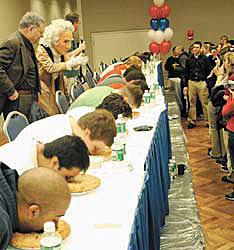 President Trachtenberg and the Colonials' mascot oversaw the third annual cherry pie-eating contest during GW’s festivities commemorating George Washington’s Birthday Saturday, Feb. 22. Two winners emerged from the close race—Jai Patel of the Sigma Nu fraternity and Tyler Coffey of GW’s Program Board. President Trachtenberg and the Colonials' mascot oversaw the third annual cherry pie-eating contest during GW’s festivities commemorating George Washington’s Birthday Saturday, Feb. 22. Two winners emerged from the close race—Jai Patel of the Sigma Nu fraternity and Tyler Coffey of GW’s Program Board.
The contest was part of an evening party in the Marvin Center Ballroom with tri-colored hats, and colonial food and music. Earlier in the day, birthday celebrations included an alumni tailgater at Alumni House, which preceded the afternoon men’s basketball game against La Salle in the Smith Center, as well as a colonial tea held in the Media and Public Affairs Building.
Photo by Claire Duggan

GW in History
25 Years Ago
Some faculty members were criticized for not showing up to class during bad weather, so at the January 1978 Faculty Senate meeting, members discussed the University’s snow policy. The Provost stated, “Classes will be cancelled at GW only in the severest cases of inclement weather … .” Because of the large amount of students on campus and within walking distance of the University, it was determined that classes will be cancelled only if governmental authorities request such action.
50 Years Ago
The faculty approved action to broaden the scope of liberal arts education at the University, “to discourage development of the so-called educated man who knows a great deal about one thing and practically nothing about all of the rest of the intellectual world.”
100 Years Ago
In 1903, per the University Bulletin, “Every applicant for admission is required to present a testimonial of good moral character … .”
The Magazine gratefully acknowledges the assistance of University Archives in the identification of interesting historical information. Readers wanting to learn more about GW’s history can find the University Archives Web site by accessing www.gwu.edu/gelman/archives. The site’s Historical Almanac is especially informative.

|